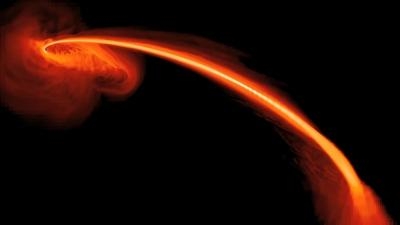Images Show Star Being Shredded By The Gravity Well
Astronomers have gathered the most direct evidence yet of a supermassive black hole shredding a star that wandered too close. NASA's Galaxy Evolution Explorer, a space-based observatory, and the Pan-STARRS1 telescope on the summit of Haleakala in Hawaii, were among the first to help identify the stellar remains.

Supermassive black holes, weighing millions to billions times more than the sun, lurk in the centers of most galaxies. These hefty monsters lay quietly until an unsuspecting victim, such as a star, wanders close enough to get ripped apart by their powerful gravitational clutches.
Astronomers have spotted these stellar homicides before, but this is the first time they identified the victim. Using several ground- and space-based telescopes, a team of astronomers led by Suvi Gezari of the Johns Hopkins University in Baltimore identified the victim as a star rich in helium gas. The star resides in a galaxy 2.7 billion light-years away. The team's results will appear in today's online edition of the journal Nature.
"When the star is ripped apart by the gravitational forces of the black hole, some part of the star's remains falls into the black hole while the rest is ejected at high speeds," Gezari said. "We are seeing the glow from the stellar gas falling into the black hole over time. We're also witnessing the spectral signature of the ejected gas, which we find to be mostly helium. It is like we are gathering evidence from a crime scene. Because there is very little hydrogen and mostly helium in the gas, we detect from the carnage that the slaughtered star had to have been the helium-rich core of a stripped star."
This observation yields insights about the harsh environment around black holes and the types of stars swirling around them. It is not the first time the unlucky star had a brush with the behemoth black hole.
The team believes the star's hydrogen-filled envelope surrounding the core was lifted off a long time ago by the same black hole. The star may have been near the end of its life. After consuming most of its hydrogen fuel, it had probably ballooned in size, becoming a red giant. Astronomers think the bloated star was looping around the black hole in a highly elliptical orbit, similar to a comet's elongated orbit around the sun. On one of its close approaches, the star was stripped of its puffed-up atmosphere by the black hole's powerful gravity. The stellar remains continued its journey around the center, until it ventured even closer to the black hole to face its ultimate demise.
Astronomers predict stripped stars circle the central black hole of our Milky Way galaxy. These close encounters are rare, occurring roughly every 100,000 years. To find this event, Gezari's team monitored hundreds of thousands of galaxies in ultraviolet light with the Galaxy Evolution Explorer, and in visible light with Pan-STARRS1. Pan-STARRS, short for Panoramic Survey Telescope and Rapid Response System, scans the entire night sky for all kinds of transient phenomena, including supernovae.

The team was looking for a bright flare in ultraviolet light from the nucleus of a galaxy with a previously dormant black hole. Both telescopes spotted one in June 2010. Astronomers continued to monitor the flare as it reached peak brightness a month later and slowly faded during the next 12 months. The brightening event was similar to the explosive energy unleashed by a supernova, but the rise to the peak was much slower, taking nearly one and a half months. "The longer the event lasted, the more excited we got, because we realized this is either a very unusual supernova or an entirely different type of event, such as a star being ripped apart by a black hole," said team member Armin Rest of the Space Telescope Science Institute in Baltimore.
By measuring the increase in brightness, the astronomers calculated the black hole's mass to be several million suns, which is comparable to the size of our Milky Way's black hole. Spectroscopic observations with the Multiple Meter Telescope Observatory located on Mount Hopkins in Arizona showed the black hole was swallowing lots of helium. Spectroscopy divides light into its rainbow colors, which yields an object's characteristics, such as its temperature and gaseous makeup.
To completely rule out the possibility of an active nucleus flaring up in the galaxy, the team used NASA's Chandra X-ray Observatory to study the hot gas. Chandra showed that the characteristics of the gas didn't match those from an active galactic nucleus.
 ANN's Daily Aero-Linx (04.16.24)
ANN's Daily Aero-Linx (04.16.24) Aero-News: Quote of the Day (04.16.24)
Aero-News: Quote of the Day (04.16.24) Airborne 04.10.24: SnF24!, A50 Heritage Reveal, HeliCycle!, Montaer MC-01
Airborne 04.10.24: SnF24!, A50 Heritage Reveal, HeliCycle!, Montaer MC-01 Airborne 04.12.24: SnF24!, G100UL Is Here, Holy Micro, Plane Tags
Airborne 04.12.24: SnF24!, G100UL Is Here, Holy Micro, Plane Tags Airborne-Flight Training 04.17.24: Feds Need Controllers, Spirit Delay, Redbird
Airborne-Flight Training 04.17.24: Feds Need Controllers, Spirit Delay, Redbird




